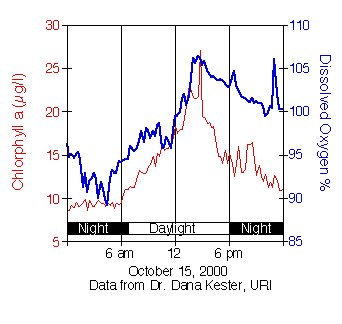1. What is chlorophyll a?
Chlorophyll is the green pigment in all plants. Chlorophyll a is the most common type of chlorophyll. Plants use chlorophyll to capture sunlight for photosynthesis. Plants may use pigments other than chlorophyll for photosynthesis but chlorophyll is the most common. Chlorophyll a is measured to estimate the abundance of phytoplankton in the water. More chlorophyll a indicates that there are more phytoplankton present.
Most chlorophyll a is found near the surface of the water because there is less light at depth. Chlorophyll a concentrations are often highest just below the surface, not at the surface of the water.
 |
| Phytoplankton need the sunlight during the day to grow. The graph below shows chlorophyll a and dissolved oxygen in the surface water for October 15, 2000 in upper Narragansett Bay (Bullock Reach). The dissolved oxygen and chlorophyll begin increasing at the same time. They both start increasing at sunrise as the phytoplankton begin photosynthesizing and producing oxygen. In mid-afternoon the chlorophyll a starts decreasing and continues decreasing after sunset. |
Chlorophyll a concentrations change with the factors that affect phytoplankton growth. Some of those factors are:
- Amount of sunlight
- Nutrient concentrations (nitrate and phosphate)
- Amount of mixing (stratification)
- Water temperature
- Water quality
| 


